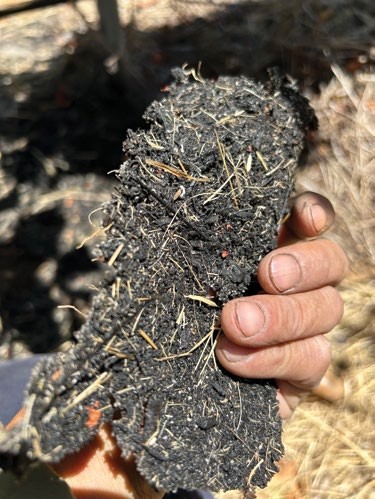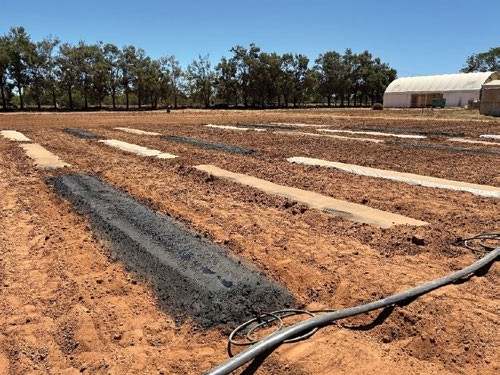FEATURE biodegradable mulch
SPRAY ON
Biodegradable Mulch
DPIRD recently collaborated with CSIRO, to assess their Sprayable Biodegradable Polymer Membrane (SBPM). The SBPM was designed to use as mulch to improve irrigation efficiencies, reduce herbicide use, and maintain healthy soils, in an array of horticultural farming systems.
Words Truyen Vo, Research Scientist, DPIRD

SBPM demonstration in wine grape vineyard in Margaret River.
THE 12 month project assessed the performance of the SBPM at demonstrations sites of pumpkin, tomato, table grapes and wine grapes across the applicable regions of Carnarvon, Swan Valley, Margaret River and Frankland River. CSIRO developed the SBPM as an alternative to conventional plastic mulch films without the negative aspects, such as its environmental impact and high costs to retrieve and dispose, whilst providing positive aspects such as preserving soil moisture, suppressing weeds, improving germination temperature and being fully biodegradable by the naturally occurring soil biome.
The SBPM showed benefits in retaining soil moisture when compared to growers’ conventional practices in light gravelly loamy and sandy soils for both table (sprinkler irrigation only) and wine grapes.



TOP 4 month old spray on SBPM from wine grapes trial. ABOVE Carnarvon SBPM demonstration site in preparation for tomato crop.
However, it failed to reduce soil water loss in vegetable crops when applied on heavy loamy alluvial soils due to the cracking of the SBPM film which consequently led to weed emergence.
The SBPM did show a promising feature where there were no observed issues with horizontal movement of irrigation water into the mid-row at one of the trial sites.
The economics of the SBPM was also considered and whilst not yet commercialised, the purchase and application costs need to be less than $2,000/ha to make it attractive as a plastic mulch alternative.
An improvement to the formulation of the SBPM is suggested to address the logistical challenges, costs of transporting and storing a product with only a 20% emulsion in water.
A refined large scale application procedure and identifying suitable equipment to ensure trouble free application will also be crucial for future adoption.
This project has shown the potential of SBPM to improve irrigation efficiencies, reduce herbicide and plastic mulch use, while supporting healthy soils and has highlighted benefits and challenges in adopting this innovative technology.
SBPM can help retain soil moisture and maintain weed control equivalent to conventional practices should the conditions favour the integrity of the SBPM film.
The team look forward to supporting further development of this product.
Cost analysis
A comprehensive cost analysis could not be investigated since the SBPM product is still to be commercialised. However, costs to apply plastic mulch were collected (see Table 1).
Considering anecdotal information, if the total costs of SBPM application achieves approximately $2,000/ha, the cost difference will be approximately $270/ha when compared to conventional plastic mulch use.



It is expected that this difference could be acceptable to growers when accounting for the social license in term of environment care and affordability.
It is possible that the cost of plastic mulch can be diluted should its use be extended to a second crop such as pumpkin or watermelon after an initial tomato crop. Making the conventional plastic mulch costings significantly lower than that of the projected SBPM product.
Soil moisture
Table 2 summarises the average daily soil moisture loss expressed as volumetric water content (VWC) across both wine and table grape sites. Table 3 summarises the average daily soil moisture loss expressed as VWC across tomato and pumpkin crops.
WAG
FOR MORE INFORMATION
Truyen Vo, truyen.vo@dpird.wa.gov.au
This project was funded by the Australian Government’s Agricultural Innovation Hubs Program and initiated through the South-West WA Drought Resilience Adoption and Innovation Hub.
